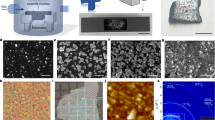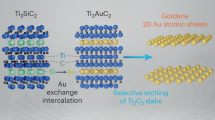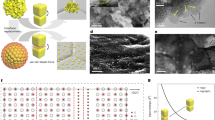Abstract
Hydrogenated amorphous and nanocrystalline silicon films manufactured by plasma deposition techniques are used widely in electronic and optoelectronic devices1,2. The crystalline fraction and grain size of these films determines electronic and optical properties; the nanocrystal nucleation mechanism, which dictates the final film structure, is governed by the interactions between the hydrogen atoms of the plasma and the solid silicon matrix. Fundamental understanding of these interactions is important for optimizing the film structure and properties. Here we report the mechanism of hydrogen-induced crystallization of hydrogenated amorphous silicon films during post-deposition treatment with an H2 (or D2) plasma. Using molecular-dynamics simulations3,4 and infrared spectroscopy5, we show that crystallization is mediated by the insertion of H atoms into strained Si–Si bonds as the atoms diffuse through the film. This chemically driven mechanism may be operative in other covalently bonded materials, where the presence of hydrogen leads to disorder-to-order transitions.
This is a preview of subscription content, access via your institution
Access options
Subscribe to this journal
Receive 51 print issues and online access
$199.00 per year
only $3.90 per issue
Buy this article
- Purchase on Springer Link
- Instant access to full article PDF
Prices may be subject to local taxes which are calculated during checkout



Similar content being viewed by others
References
Shah, A., Torres, P., Tscharner, R., Wyrsch, N. & Keppner, H. Photovoltaic technology: the case for thin-film solar cells. Science 285, 692–698 (1999)
Street, R. A. Large area electronics, applications and requirements. Phys. Status Solidi A 166, 695–705 (1998)
Maroudas, D. Modeling of radical-surface interactions in the plasma-enhanced chemical vapor deposition of silicon thin films. Adv. Chem. Eng. 28, 251–296 (2001)
Ramalingam, S., Sriraman, S., Aydil, E. S. & Maroudas, D. Evolution of structure, morphology, and reactivity of hydrogenated amorphous silicon film surfaces grown by molecular-dynamics simulation. Appl. Phys. Lett. 78, 2685–2687 (2001)
Marra, D. C., Edelberg, E. A., Naone, R. L. & Aydil, E. S. Silicon hydride composition of plasma-deposited hydrogenated amorphous and nanocrystalline silicon films and surfaces. J. Vac. Sci. Technol. A 16, 3199–3210 (1998)
Abelson, J. R. Plasma deposition of hydrogenated amorphous silicon: studies of the growth surface. Appl. Phys. A 56, 493–512 (1993)
Layadi, N., Roca i Cabarrocas, P., Drevillon, B. & Solomon, I. Real-time spectroscopic ellipsometry study of the growth of amorphous and microcrystalline silicon thin films prepared by alternating silicon deposition and hydrogen plasma treatment. Phys. Rev. B 52, 5136–5143 (1995)
Saitoh, K. et al. Role of the hydrogen plasma treatment in layer-by-layer deposition of microcrystalline silicon. Appl. Phys. Lett. 71, 3403–3405 (1997)
Kaiser, I., Nickel, N. H., Fuhs, W. & Pilz, W. Hydrogen-mediated structural changes of amorphous and microcrystalline silicon. Phys. Rev. B 58, R1718–R1721 (1998)
Fontcuberta i Morral, A., Bertomeu, J. & Roca i Cabarrocas, P. The role of hydrogen in the formation of microcrystalline silicon. Mater. Sci. Eng. B 69, 559–563 (2000)
Summonte, C. et al. Plasma-enhanced chemical vapour deposition of microcrystalline silicon: on the dynamics of the amorphous-microcrystalline interface by optical methods. Phil. Mag. B 80, 459–473 (2000)
Edelberg, E., Bergh, S., Naone, R., Hall, M. & Aydil, E. S. Luminescence from plasma deposited silicon films. J. Appl. Phys. 81, 2410–2417 (1997)
Roca i Cabarrocas, P. Plasma enhanced chemical vapor deposition of amorphous, polymorphous and microcrystalline silicon films. J. Non-Cryst. Solids 266, 31–37 (2000)
Nomoto, K., Urano, Y., Guizot, J. L., Ganguly, G. & Matsuda, A. Role of hydrogen atoms in the formation process of hydrogenated microcrystalline silicon. Jpn J. Appl. Phys. 2 29, L1372–L1375 (1990)
Katiyar, M. & Abelson, J. R. Investigation of hydrogen induced phase transition from a-Si:H to μc-Si:H using real time infrared spectroscopy. Mater. Sci. Eng. A 304, 349–352 (2001)
Tsai, C. C., Anderson, G. B., Thompson, R. & Wacker, B. Control of silicon network structure in plasma deposition. J. Non-Cryst. Solids 114, 151–153 (1989)
Boland, J. J. & Parsons, G. N. Bond selectivity in silicon film growth. Science 256, 1304–1306 (1992)
Nickel, N. H. & Jackson, W. B. Hydrogen-mediated creation and annihilation of strain in amorphous silicon. Phys. Rev. B 51, 4872–4881 (1995)
Shirai, H., Hanna, J. & Shimizu, I. Role of atomic hydrogen during growth of hydrogenated amorphous silicon in the ‘chemical annealing’. Jpn J. Appl. Phys. 2 30, L679–L682 (1991)
Van de Walle, C. G., Denteneer, P. J. H., Bar-Yam, Y. & Pantelides, S. T. Theory of hydrogen diffusion and reactions in crystalline silicon. Phys. Rev. B 39, 10791–10808 (1989)
Tuttle, B. & Adams, J. B. Energetics of hydrogen in amorphous silicon: An ab initio study. Phys. Rev. B 57, 12859–12868 (1998)
Chabal, Y. J. Surface infrared spectroscopy. Surf. Sci. Rep. 8, 211–357 (1988)
Jun, X. et al. Device-grade a-SiGe:H alloys prepared by nanometer deposition/H2 plasma annealing method. J. Non-Cryst. Solids 200, 582–586 (1996)
Tersoff, J. New empirical approach for the structure and energy of covalent systems. Phys. Rev. B 37, 6991–7000 (1988)
Ohira, T., Ukai, O., Adachi, T., Takeuchi, Y. & Murata, M. Molecular-dynamics simulations of SiH3 radical deposition on hydrogen-terminated silicon (100) surfaces. Phys. Rev. B 52, 8283–8287 (1995)
Ramalingam, S., Maroudas, D. & Aydil, E. S. Interactions of SiH radicals with silicon surfaces: An atomic-scale simulation study. J. Appl. Phys. 84, 3895–3911 (1998)
Ramalingam, S., Maroudas, D. & Aydil, E. S. Atomistic simulation study of the interactions of SiH3 radicals with silicon surfaces. J. Appl. Phys. 86, 2872–2888 (1999)
Ramalingam, S., Maroudas, D., Aydil, E. S. & Walch, S. P. Abstraction of hydrogen by SiH3 from hydrogen-terminated Si(001)-(2 × 1) surfaces. Surf. Sci. 418, L8–L13 (1998)
Walch, S. P., Ramalingam, S., Aydil, E. S. & Maroudas, D. Mechanism and energetics of dissociative adsorption of SiH3 on the hydrogen-terminated Si(001)-(2 × 1) surface. Chem. Phys. Lett. 329, 304–310 (2000)
Walch, S. P., Ramalingam, S., Sriraman, S., Aydil, E. S. & Maroudas, D. Mechanism and energetics of SiH3 adsorption on the pristine Si(001)-(2 × 1) surface. Chem. Phys. Lett. 344, 249–255 (2001)
Acknowledgements
This work was supported by the NSF/DoE Partnership for Basic Plasma Science and Engineering and by the Camille and Henry Dreyfus Foundation through Camille Dreyfus Teacher-Scholar awards to E.S.A. and D.M.
Author information
Authors and Affiliations
Corresponding authors
Ethics declarations
Competing interests
The authors declare that they have no competing financial interests.
Rights and permissions
About this article
Cite this article
Sriraman, S., Agarwal, S., Aydil, E. et al. Mechanism of hydrogen-induced crystallization of amorphous silicon. Nature 418, 62–65 (2002). https://doi.org/10.1038/nature00866
Received:
Accepted:
Issue Date:
DOI: https://doi.org/10.1038/nature00866
This article is cited by
-
High-Throughput Low Frequency Reactor for Non-Thermal Plasma Synthesis of Amorphous Silicon Nanoparticles
Silicon (2024)
-
A Comparative Study on the Anti-Friction Performance of Amorphous Silicon Films Enhanced by WS2 Nanoflakes
Silicon (2023)
-
Observation of resonant exciton and correlated plasmon yielding correlated plexciton in amorphous silicon with various hydrogen content
Scientific Reports (2022)
-
Light-induced activation of boron doping in hydrogenated amorphous silicon for over 25% efficiency silicon solar cells
Nature Energy (2022)
-
Experimental and molecular dynamics studies of an ultra-fast sequential hydrogen plasma process for fabricating phosphorene-based sensors
Scientific Reports (2021)
Comments
By submitting a comment you agree to abide by our Terms and Community Guidelines. If you find something abusive or that does not comply with our terms or guidelines please flag it as inappropriate.



